What Year Did George Eastman Invented The First Handheld Camera And Rolled Film
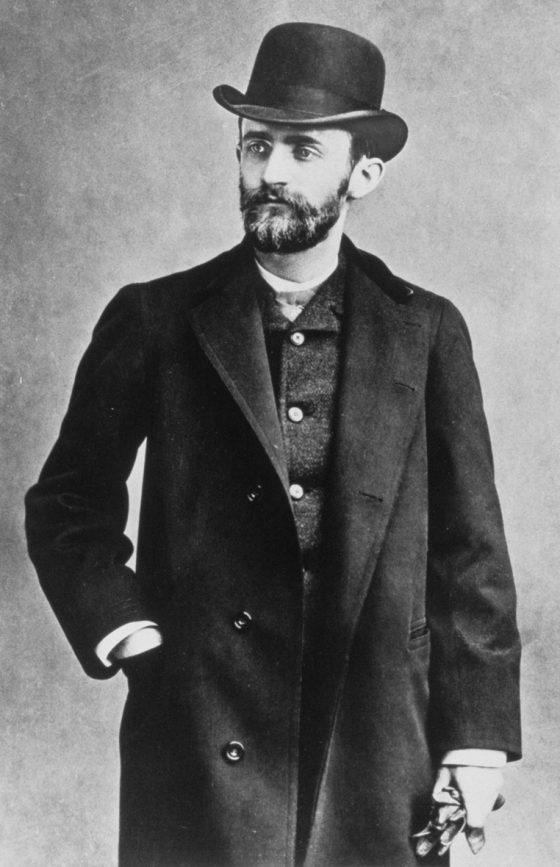
He was a high school dropout, judged "not especially gifted" when measured against the academic standards of the day. He was poor, but even as a young man, he took it upon himself to support his widowed mother and two sisters, one of whom had polio.
He began his business concern career as a 14-twelvemonth old office boy in an insurance visitor and followed that with work as a clerk in a local bank.
He was George Eastman, and his power to overcome financial adversity, his gift for organisation and management, and his lively and inventive listen made him a successful entrepreneur by his mid-twenties, and enabled him to directly his Eastman Kodak Company to the forefront of American industry.
But building a multinational corporation and emerging equally one of the nation'due south nigh of import industrialists required dedication and cede. It did not come easily.
The youngest of three children, George Eastman was built-in to Maria Kilbourn and George Washington Eastman on July 12, 1854 in the village of Waterville, some 20 miles southwest of Utica, in upstate New York. The business firm on the old Eastman homestead, where his begetter was born and where George spent his early years, has since been moved to the Genesee Country Museum in Mumford, Due north.Y., outside of Rochester
When George was five years old, his begetter moved the family to Rochester. There the elder Eastman devoted his energy to establishing Eastman Commercial College. Then tragedy struck. George's male parent died, the college failed and the family became financially distressed.
George continued school until he was 14. Then, forced by family circumstances, he had to notice employment.
His first job, as a messenger boy with an insurance house, paid $3 a week. A year later, he became part male child for some other insurance firm. Through his own initiative, he shortly took accuse of policy filing and fifty-fifty wrote policies. His pay increased to $v per week.
Simply, even with that increase, his income was non enough to run across family expenses. He studied accounting at abode evenings to become a better paying job.
In 1874, subsequently five years in the insurance business concern, he was hired as a junior clerk at the Rochester Savings Bank. His salary tripled -- to more than than $xv a calendar week.
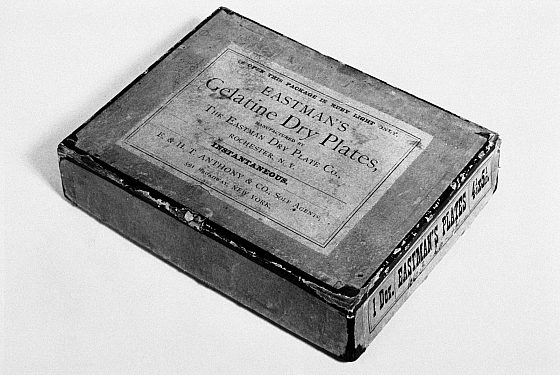
When Eastman was 24, he made plans for a vacation to Santo Domingo. When a co-worker suggested he make a record of the trip, Eastman bought a photographic outfit with all the paraphernalia of the wet plate days.
The camera was as big as a microwave oven and needed a heavy tripod. And he carried a tent so that he could spread photographic emulsion on drinking glass plates before exposing them, and develop the exposed plates earlier they dried out. In that location were chemicals, glass tanks, a heavy plate holder, and a jug of h2o. The consummate outfit "was a pack-horse load," as he described it. Learning how to use it to take pictures toll $v
Eastman did not make the Santo Domingo trip. Simply he did go completely absorbed in photography and sought to simplify the complicated process.
He read in British magazines that photographers were making their own gelatin emulsions. Plates coated with this emulsion remained sensitive afterward they were dry and could be exposed at leisure. Using a formula taken from 1 of these British journals, Eastman began making gelatin emulsions.
He worked at the bank during the day and experimented at home in his mother'due south kitchen at dark. His mother said that some nights Eastman was so tired he couldn't undress, only slept on a coating on the floor beside the kitchen stove.
After three years of photographic experiments, Eastman had a formula that worked. Past 1880, he had not only invented a dry out plate formula, but had patented a motorcar for preparing large numbers of the plates. He quickly recognized the possibilities of making dry plates for auction to other photographers.
In 1879, London was the centre of the photographic and concern world. George Eastman went at that place to obtain a patent on his plate-coating machine. An American patent was granted the following yr.
In April 1880, Eastman leased the tertiary floor of a building on State Street in Rochester, and began to manufacture dry plates for sale. One of his kickoff purchases was a 2d-mitt engine priced at $125.
"I actually needed only a one equus caballus-power," he later recalled. "This was a two horse-ability, just I thought maybe business organisation would grow up to it. Information technology was worth a chance, and then I took information technology."
Success of the dry plate venture so impressed man of affairs Henry A. Strong, that he invested some money in the babe concern.
On Jan 1, 1881, Eastman and Potent formed a partnership called the Eastman Dry Plate Company. Tardily that yr, Eastman resigned from his position at the Rochester Savings Banking company to devote all his fourth dimension to the new company and its business. While actively managing all phases of the firm's activities, he continued research in an attempt to simplify photography.
In 1884, the Eastman-Stiff partnership had given way to a new firm -- the Eastman Dry out Plate and Picture Company -- with 14 shareowners. A successive business concern -- the Eastman Visitor, was formed in 1889.
The visitor has been chosen Eastman Kodak Company since 1892, when Eastman Kodak Company of New York was organized. In 1901, the Eastman Kodak Company of New Bailiwick of jersey was formed under the laws of that state.
Eastman built his business on 4 basic principles:
- a focus on the customer
- mass production at depression toll
- worldwide distribution
- extensive advert
He saw all four equally being closely related. Mass production could not be justified without wide distribution. Distribution, in turn, needed the support of strong advert. From the beginning, he imbued the company with the conviction that fulfilling customer needs and desires is the only road to corporate success.
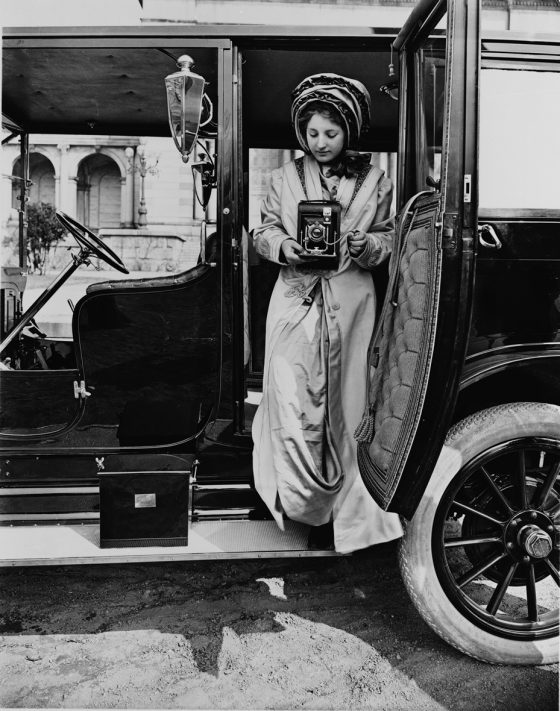
As Eastman's immature company grew, information technology faced total collapse at least one time when dry out plates in the easily of dealers went bad. Eastman recalled them and replaced them with a skillful production. "Making good on those plates took our final dollar," he said. "But what we had left was more important -- reputation."
"The idea gradually dawned on me," he later said, "that what we were doing was not only making dry out plates, merely that we were starting out to make photography an everyday matter." Or as he described it more succinctly "to brand the camera as user-friendly as the pencil."
Eastman's experiments were directed to the use of a lighter and more than flexible support than drinking glass. His kickoff approach was to coat the photographic emulsion on newspaper and then load the newspaper in a curlicue holder. The holder was used in view cameras in place of the holders for glass plates.
In 1883, Eastman startled the merchandise with the declaration of picture in rolls, with the whorl holder adjustable to well-nigh every plate Photographic camera on the market.
The starting time film advertisements in 1885 stated that "shortly there will be introduced a new sensitive film which it is believed will prove an economic and user-friendly substitute for glass dry plates both for outdoor and studio work."
This system of photography using curl holders was immediately successful. However, newspaper was non entirely satisfactory as a carrier for the emulsion because the grain of the paper was likely to be reproduced in the photograph.
Eastman's solution was to coat the paper with a layer of manifestly, soluble gelatin, and then with a layer of insoluble calorie-free-sensitive gelatin. Later exposure and development, the gelatin bearing the image was stripped from the paper, transferred to a canvas of clear gelatin, and varnished with collodion -- a cellulose solution that forms a tough, flexible pic.
Equally he perfected transparent roll film and the roll holder, Eastman inverse the whole direction of his work and established the base on which his success in amateur photography would be built.
He later on said: "When nosotros started out with our scheme of film photography, nosotros expected that everybody who used drinking glass plates would take upwards films. Merely we found that the number which did so was relatively small. In order to make a large business organisation we would accept to reach the general public."
With the KODAK Photographic camera in 1888, Eastman put downward the foundation for making photography available to everyone. Pre-loaded with enough film for 100 exposures, the camera could be hands carried and handheld during functioning. It was priced at $25. Later exposure, the whole camera was returned to Rochester. There the flick was developed, prints were fabricated and new picture show was inserted -- all for $ten.
Eastman's religion in the importance of ad, both to the company and to the public, was unbounded. The very first Kodak products were advertised in leading papers and periodicals of the day -- with ads written by Eastman himself.
Eastman introduced the Kodak camera in 1888. Cheers to his inventive genius, anyone could now have pictures with a handheld camera only by pressing a button. He coined the slogan, "you press the push button, we do the rest," and within a year information technology became a well-known phrase. After, with advertising managers and agencies conveying out his ideas, magazines, newspapers, displays and billboards diameter the Kodak imprint.
Space was taken at earth expositions, and the "Kodak Daughter," with the style of her dress and the camera she carried irresolute every year, smiled engagingly at photographers everywhere. In 1897, the give-and-take "Kodak" sparkled from an electric sign on London'south Trafalgar Square -- one of the commencement such signs to be used in advertising.
The word "Kodak" was first registered as a trademark in 1888. There has been some fanciful speculation, from time to time, on how the name was originated. But the plain truth is that Eastman invented it out of thin air.
He explained: "I devised the proper name myself. The letter 'K' had been a favorite with me -- it seems a stiff, incisive sort of letter. It became a question of trying out a great number of combinations of letters that made words starting and ending with 'K.' The word 'Kodak' is the result." Eastman likewise selected Kodak's distinctive yellowish merchandise dress, which is widely known throughout the world.
To his basic principles of business, Eastman added these policies:
- foster growth and development through continuing inquiry
- reinvest profits to build and extend the business, and
- treat employees in a fair, cocky-respecting way
In regards to his employees and in building his business concern, Eastman composite human and democratic qualities, with remarkable foresight. He believed employees should accept more just skillful wages -- a way of thinking that was far ahead of management people of his era.
Early in his business, Eastman began planning for "dividends on wages" for employees. His first human action, in 1899, was the distribution of a substantial sum of his own coin -- an outright gift -- to each person who worked for him
Later he set upward a "Wage Dividend" – an innovation for its fourth dimension – in which each employee benefited above his or her wages in proportion to the yearly dividend on the company stock.
Eastman felt that the prosperity of an organization was not necessarily due to inventions and patents, but more to workers' goodwill and loyalty, which in turn were enhanced by forms of profit sharing.
In 1919, Eastman gave one-third of his ain holdings of company stock – then worth $x million – to his employees. Still later came the fulfillment of what he felt was a responsibility to employees with the establishment of retirement annuity, life insurance, and disability benefit plans.
Carl Due west. Ackerman, a biographer writing in 1932, said: "Mr. Eastman was a giant in his day. The social philosophy, which he practiced in building his company, was not only far in advance of the thinking during his lifetime, simply it will be years before it is by and large recognized and accepted."
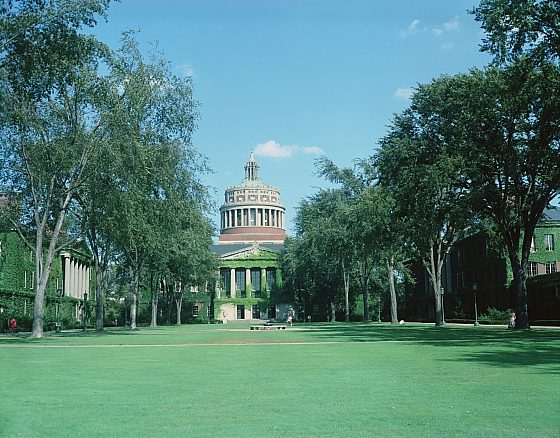
Eastman is almost as well known for his philanthropy as he is for his pioneering work in photography. In this field, equally in others, he put the direction of an enthusiastic amateur to work.
He began giving to nonprofit institutions when his salary was $threescore a week -- with a donation of $50 to the immature and struggling Mechanics Constitute of Rochester, now the Rochester Institute of Engineering.
He was an gentleman of the Massachusetts Institute of Technology because he had hired some of its graduates, who had become his best administration. This adoration, afterward thorough study, was translated into a handsome gift to One thousand.I.T., somewhen reaching $20 million. Information technology was given anonymously from a "Mr. Smith," and for several years the identity of the mysterious "Mr. Smith" was speculated about, even finding expression in a popular G.I.T. song.
"If a man has wealth, he has to brand a choice, because there is the money heaping upward. He can keep it together in a agglomeration, and and then leave information technology for others to administer after he is dead. Or he tin get it into action and take fun, while he is still live. I prefer getting it into action and adapting information technology to human needs, and making the plan work."
- George Eastman
Dental clinics were besides of great interest to Eastman. He devised complete plans and financial backing for a $2.5 million dental clinic for Rochester. He then started a large-scale, remedial dental program for children. Dental clinics were likewise given to London, Paris, Rome, Brussels and Stockholm.
When asked why he favored dental clinics, he replied, "I go more results for my money than in any other philanthropic scheme. It is a medical fact that children can take a better chance in life with better looks, better health and more than vigor if the teeth, nose, throat and mouth are taken proper care of at the crucial time of babyhood."
Eastman loved music and wanted others to enjoy the beauty and pleasance of music. He established and supported the Eastman School of Music, a theatre, and a symphony orchestra. "It is fairly easy to use skillful musicians. Information technology is incommunicable to purchase appreciation of music. Yet without a large body of people who get joy out of it, any effort to develop musical resources of any city is doomed to failure," he said. So his plan had a practical formula for exposing the public to music -- with the result that the people of Rochester have for decades supported their ain philharmonic orchestra.
Interest in hospitals and dental clinics had grown with Eastman's work and written report of the field. He promoted and brought to fruition a program to develop a medical school and hospital at the University of Rochester, which became equally nationally prominent equally the university'due south music schoolhouse. Rochester is filled with Eastman landmarks that contribute to the enrichment of community life.
His sincere business organisation for the educational activity of African Americans brought gifts to the Hampton and the Tuskegee Institutes. One twenty-four hour period in 1924, Eastman signed away $xxx million to the Academy of Rochester, M.I.T., Hampton and Tuskegee. As he laid down the pen he said, "Now I experience better."
In explaining these large gifts, he said, "The progress of the world depends almost entirely upon didactics. I selected a limited number of recipients because I wanted to cover certain kinds of educational activity, and felt I could become results with those named quicker and more than directly than if the coin were spread."
Eastman often fabricated the beneficiary lucifer his gift in some way, and then the establishment would accept the conviction of standing on its ain. For him, great wealth brought the greater opportunity to serve.
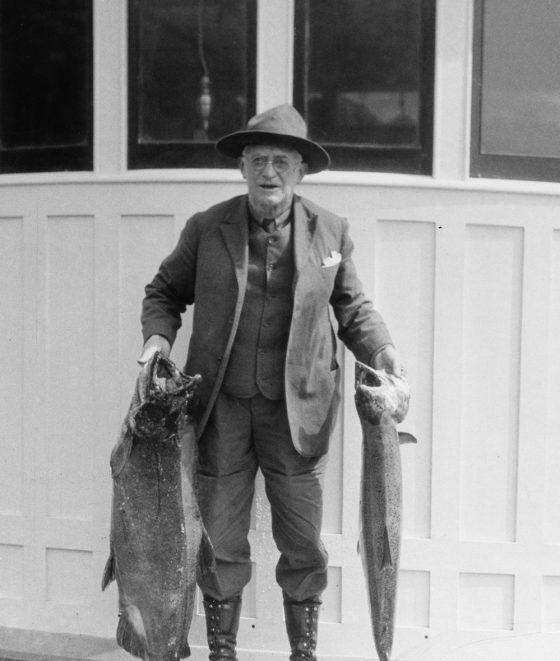
Eastman was reticent and shunned publicity. It seems paradoxical that the man whose name is synonymous with photography should have fewer photographs taken of him than many other outstanding leaders of his time. He could walk down the main street of Rochester without beingness recognized.
Eastman lived his philosophy, "What we practice during our working hours determines what we have; what we practise in our leisure hours determines what nosotros are." A tough competitor, hard-bitten and applied in business, he was gentle and congenial at home or in the field of outdoor enjoyment.
In his yearly visits to Europe, he toured the art galleries methodically -- even cycling from place to place. By the fourth dimension he could afford masterpieces, he had learned enough to say, "I never purchase a painting until I accept lived with it in my dwelling house." The result: his home became the showplace of 1 of the finest private collections of paintings.
He was a modest, unassuming human... an inventor, a marketer, a global visionary, a philanthropist, and a champion of inclusion.
Eastman died past his ain mitt on March 14, 1932 at the age of 77. Plagued past progressive inability resulting from a hardening of the cells in the lower spinal cord, Eastman became increasingly frustrated at his inability to maintain an active life, and gear up about putting his estate in gild.
"Eastman was a stupendous factor in the educational activity of the modern earth," said an editorial in The New York Times post-obit his expiry. "Of what he got in return for his bang-up gifts to the man race he gave generously for their adept; fostering music, endowing learning, supporting science in its researches and teaching, seeking to promote wellness and lessen human being ills, helping the lowliest in their struggle toward the lite, making his own city a centre of the arts and glorifying his own state in the eyes of the world."
Learn More
Acquire More about Kodak, photography, and the legacy of George Eastman by visiting the George Eastman Museum in Rochester, N.Y.
George Eastman Museum
Source: https://www.kodak.com/en/company/page/george-eastman-history
Posted by: pearsoncoight.blogspot.com

0 Response to "What Year Did George Eastman Invented The First Handheld Camera And Rolled Film"
Post a Comment